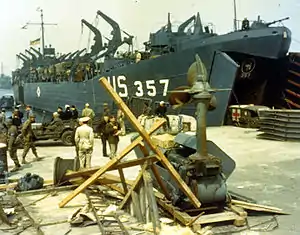USS LST-357
USS LST-357 was an LST-1-class tank landing ship of the United States Navy active during the Second World War. Whilst never formally named, she was nicknamed Palermo Pete by her crew.
 LST-357 loading vehicles before the Normandy invasion | |
| History | |
|---|---|
| Name: | USS LST-357 |
| Builder: | Charleston Navy Yard |
| Laid down: | 24 October 1942 |
| Launched: | 16 November 1942 |
| Commissioned: | 8 February 1943 |
| Decommissioned: | 8 June 1946 |
| Stricken: | 31 July 1946 |
| Honours and awards: | 3 battle stars |
| Fate: | Sold for scrap, 1 April 1948 |
| General characteristics | |
| Class and type: | LST-1-class tank landing ship |
| Displacement: | 4,080 long tons (4,145 t) full |
| Length: | 328 ft (100 m) |
| Beam: | 50 ft (15 m) |
| Draft: |
|
| Propulsion: | 2 × General Motors 900 hp (671 kW) 12-567 diesel engines, 2 shafts, twin rudders |
| Speed: | 12 knots (22 km/h; 14 mph) |
| Range: | 24,000 nmi (44,000 km) at 9 kn (17 km/h; 10 mph) while displacing 3960 tons |
| Complement: | 9 officers, 120 enlisted |
| Armament: | |
Service history
She was laid down in October 1942 at the Charleston Navy Yard, and commissioned in February 1943.
LST-357 first saw service at the invasion of Sicily in July 1943. During the Salerno landings on September 9, a crew of just under 150 all ranks took some 90 casualties. One crew member, Warren C. Gill, was awarded the Navy Cross for his actions, making him one of just six Coast Guardsmen to be awarded the Navy Cross during World War II.[1]
In 1944 she moved to England to support the Normandy landings, landing on Omaha Beach on D-Day.
Following the end of the war, she served on occupation duties in the Far East, before being decommissioned in June 1946 and sold for scrapping in April 1948.
Notes
- "Warren Gill, Oregon's Forgotten Navy Cross Hero". The Maritime Executive.
References
- Photo gallery of LST-357 at NavSource Naval History
- This article incorporates text from the public domain Dictionary of American Naval Fighting Ships. The entry can be found here.